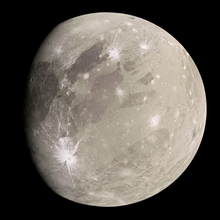Wikijunior:Solar System/Jupiter/Ganymede

Ganymede Facts:
- Ganymede is the only moon of Jupiter discovered by Galileo to be named after a male person.
- Ganymede, the Solar System's largest moon, is larger than either Mercury or Pluto.
- Ganymede is the only moon to have a magnetic field.
- Ganymede is the largest moon in the solar system.
How big is Ganymede?
[edit | edit source]Ganymede is 5262.4 km, or 0.413 Earths wide, making it a little larger than the Earth's moon. It is the largest of Jupiter's moons — in fact it is the largest moon in the solar system.

What is its surface like?
[edit | edit source]
The surface of Ganymede is divided into two regions: dark regions, and light regions. The dark regions are very old and highly cratered, while the light regions are younger (but still quite old), and marked by grooves and ridges. However, craters are found on both types of terrain, and are around 3 to 31/2 billion years old.
Ganymede's crust is made of water ice. Like Earth's crust, it is broken up into plates, which can move. Along the fracture zones, mountain ranges have formed. Because the crust can flow, craters tend to be flat. Sometimes, old craters become palimpsests because of erosion casued by the crust.
Recently, the Hubble Space Telescope found evidence of an oxygen atmosphere on Ganymede. This does not mean that there is life on Ganymede; it is believed that the oxygen is produced when radiation splits the water ice (H2O) into hydrogen and oxygen. The hydrogen is lost because it has a low mass, while the oxygen forms the atmosphere.
How long is a day on Ganymede?
[edit | edit source]One day on Ganymede is equal to about 7.15 days on Earth.
How long is its orbit around Jupiter?
[edit | edit source]It takes Ganymede 7.15 days to orbit Jupiter. Ganymede orbits Jupiter at the same speed that it spins.
Who is it named after?
[edit | edit source]
Ganymede (Greek Γανυμήδης) is named after a handsome Trojan boy who was made cupbearer to the gods by Jupiter (also known as Zeus).
How was it discovered?
[edit | edit source]Ganymede was discovered by Galileo Galilei and Simon Marius. Galileo found it on January 11, 1610, and Marius around the same time.
